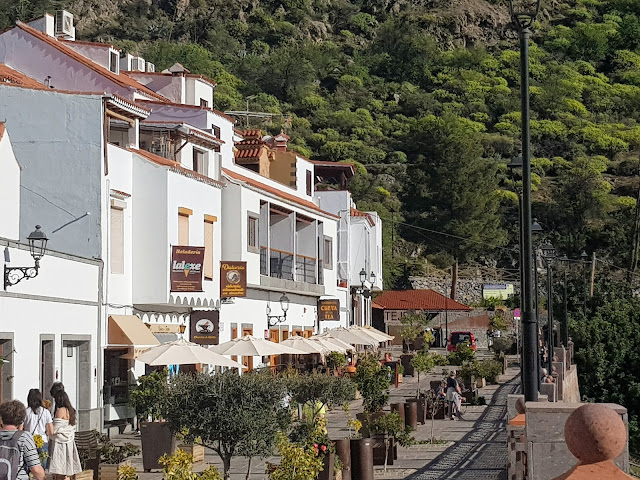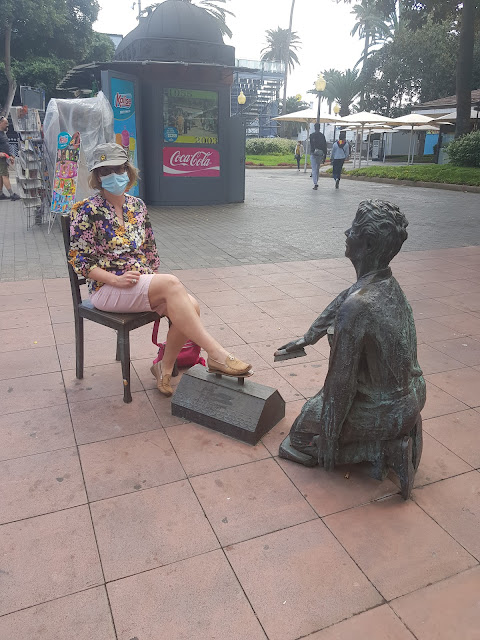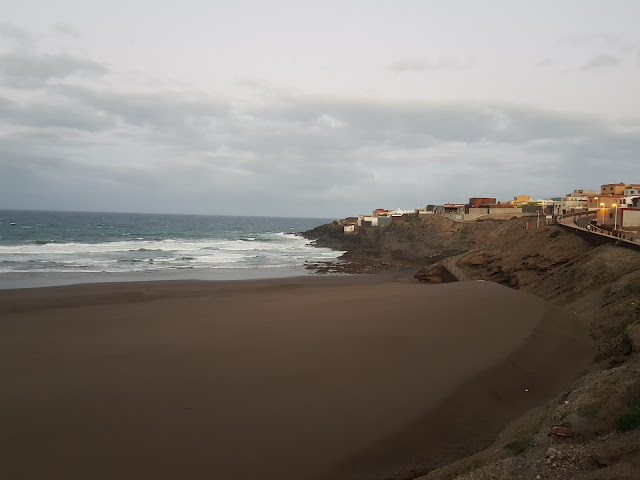Our location in Playa del Hombre means we really have to have a car in order to get the best out of this holiday. In Gran Canaria there is really only two choices. You head to the hills or you head to the beaches. Today it's the former, indeed you can't get higher than the highest peak on the island Pico de las Nieves which stands at 1,949 metres. By coincidence this happens to be the same numbers as my birth year.
Although relatively small (the circumference is 235 kms) the island displays a remarkable variety of landscapes. Ar id larval desert that only supports stubborn socially isolated cacti and the odd lizard if your eyesight is quick enough to spot that tail-flicking movement, is juxtaposed with lush verdant slopes supporting a cornucopia of agriculture. Clearly the answer lies in the microclimate. Ironically the bananas seem to be grown in those really dry areas. Presumably these are the sunniest ie cloud free districts,but more of bananas later. Let's look at some hillside farming. Terracing is of course essential with slopes like these and many are decades if not centuries old,

Some handy clouds here to support my theory. Talking of cloud, we encountered these in abundance at the top of Pico de las Nieves. Unusually we could drive right to the top and the reason why is that the summit is shared with a military base hence the road was constructed. If you have ever wondered who is watching you, well it's everyone, but also someone on the top of this mountain.
Seconds later the view becomes this.
And in a few more seconds..........
And if you are interested in seeing the military base, look quickly as it's a restricted area.
The next view point was also affected by cloud cover. This is the Caldera (crater) de los Marteles. It is 80 metres down to the bottom and 550 metres across. The landscape was created by an explosive phreatomagmatic eruption or for the layman when larva comes into contact with underground water. It occurred about a million years ago. The crater has a flat bottom and weather permitting you can see the geometric lines of ploughing showing that agriculture has been a traditional activity on this relatively flat land. In Wales it would have been a rugby stadium.

We continued downwards heading for a ravine type valley which has been inhabited constantly since the first indigenous peoples arrived on the island. The location represents the greatest density of archaeological sites spread along both slopes of the ravine among which troglodyte habitats abound, under escarpment ledges and on hillsides. It is considered to be one of the most stunning cultural landscapes in Gran Canaria. This troglodytic lifestyle has persisted even up to the present day.
The caves are clearly visible in the rock cliffs. As well as habitations the caves were used for storage and burial purposes. Access to many of the caves is very difficult and the remains of ancestors still remain undisturbed where they were first laid to rest many hundreds of years ago.
This historic landscape has not however remained static. It has evolved and adapted to present day living.
Meet our friend, the present day troglodyte and his humble abode. This is his washing up area which has running water..
The cave is also supplied with mains electricity for lighting and the television (He was watching Death in Paradise when we called.) Some of the homes ran on portable generators. He earned a few Euros each day showing people round his home. Below you can see his hallway, the green door leads through to the bedroom/living room.
He had a few "museumy bits" to illustrate his story.
Above is his double bed that he shared with his senhora until sadly she died of a brain haemorrhage. Now he shares a single bed, cut from the rock face, with his little dog, if you see what I mean. We moved on to another place where life has stood still.
Aguimes has become the best example of a Canarian hill town. The streets of the old town exude a gentle, relaxed, timeless atmosphere and carefully positioned street statues and sculptures add a series of surprises to a visit to the old town.
There had been a festival of sorts taking place earlier today. We encountered a group of women in the square who were still determined to enjoy themselves singing and dancing.
Some of the surprises are bigger than others. Why the nude cellist? It brought to mind that famous quote by Sir Thomas Beecham "Madam you have between your legs an instrument that can give pleasure to thousands but all you can do is scratch it. "
Who can resist a camel ride when it's on offer for free? Certainly this beast was much easier to mount than Helen's last one in the Thar Desert in India.
























































